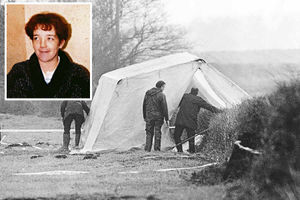Murder, child abduction and modern slavery - More than one million crimes remain unsolved in West Mercia Police force area
More than a million crimes, such as murder, child abduction, modern slavery and arson endangering life, remain unsolved by police in our region.

Figures obtained by the Shropshire Star shows that officers have been unable to close 1,119, 890 cases spanning a period of 27 years.
This means there were on average 41,477 crimes a year in the West Mercia Police force area that have gone unsolved since 1988.
Five murders remain unsolved, 14 attempted murders, 673 cases of threat or conspiracy to murder, 1,127 cases of threats to kill and nine of manslaughter.
Police chiefs for West Mercia Police force said today there were many reasons why some crimes lie on file, from lack of evidence or when a suspect was below the age limit. Other crimes that remain unresolved including 34 cases of abuse of children through prostitution and pornography and five cases of modern slavery.
A total of 246 cases of kidnapping remain unsolved, 229 of blackmail, seven abductions and 125 cases of child abduction, 15 of these took place this year.
There were also 73 cases of a person absconding from custody.
Many unsolved crimes relate to cases of violent and sexual offences – including more than 2,000 rapes of women and 915 reports of rape of girls under 16.There were 69 cold cases concerning rape of men and almost 200 of boys under 16.
This would be when every avenue of investigation was exhausted but there was still insufficient evidence.
The highest numbers of unsolved offences were concerning theft, with more than 160,000, theft from a vehicle, at a total of 147,178, and burglary at 89,000.
The single crime dating back to 1988 was for a fraud offence.
Connie Osborne, of West Mercia Police, reminded people that all investigations could be reopened.
Other reasons why cases were classified as unsolved could be due to a key witness or victim no longer wanting to support prosecution.
She said: "We also look at other ways to ensure lower level incidents are dealt with. This may be through crime prevention and local policing initiatives which encourage the public to keep themselves and their belongings safe and negate the risk of crime.
"Our focus will always remain on ensuring victims of crime are taken seriously and we endeavour to provide the best possible outcome for them."
The figures revealed by the Freedom of Information Act cover the West Mercia Police area including Shropshire, Herefordshire and Worcestershire.
Each crime is recorded under the relevant category and could eventually end up in another as investigations progress.
Off the books justice served

It was 24 years ago when Janine Downes' battered body was discovered in a Shropshire lay-by.
It is perhaps the most notorious of the cases that remain unsolved by police in our region.
Figures revealed today show more than a million crimes, such as murder, child abduction, modern slavery and arson endangering life, remain on file.
There are five recorded murders that remain a mystery, according to the figures.
The most recent case concerns the tragic death of Christian Bagley who was killed as he walked home in June in Hereford.
Detective constable Steve Williams, who works for West Mercia Police in the Major Incident Unit, is part of a team that deals with cold case murders. His aim is to get the most serious cases 'off the books' – bring those responsible to justice and help the families of victims find closure.
He said his team had reviewed the killing of Miss Downes', a 22-year-old mother of three, whose body was concealed by a small hedge near Lambert's Restaurant on the A464 Shifnal to Wolverhampton road in 1991.
He said: "These unsolved cases are reviewed at stages and passed onto the relevant department to investigate again. We deal with cold case murders in the area.
"We have a lot of empathy with the loved ones of these victims because it is awful to not know what has happened. It is our duty but we also really want to close these cases."
Fresh work was undertaken to identify Miss Downes's killer in 2013.
The new investigation was part of a procedure in which cold cases are revisited.
Evidence from the time was re-examined using the most modern forensic techniques, some of which were not available at the time of the murder.
The body of Miss Downes, who had worked as a prostitute, was found just before 9.30am on February 2, 1991. Following her death, a post-mortem examination showed she was strangled and had extensive head wounds. She had been sexually assaulted. Clothes from the bottom half of Miss Downes's body and her trainers were missing.
Following the killing, a West Mercia Police pathologist estimated her body had been left there between midnight and 4am. Her last known movements were in Wolverhampton's red light district and detectives believed she had been killed by a client.
Detectives revealed in 2011 they were following up potential new leads after a fresh appeal led to a number of phone calls. The detective leading the hunt for the killer said he was convinced someone knew who killed her as he revisited the lay-by.

Mr Williams also told of one his team's best results after a cold case review. He said this was in the case of Shrewsbury killer Robin Ligus.
The convicted murderer, who killed a pensioner in 1994, was found responsible for killing two others in the same year after a cold case probe.
Ligus, a 59-year-old former painter and decorator, who was jailed for life for killing Robert Young in 1994, was found responsible for the unlawful killings of both Trevor Bradley and Brian Coles by a jury at Birmingham Crown Court.
The month-long trial heard Ligus, who was desperate for money to buy drugs, killed Mr Bradley near Melverley in April 1994 by knocking him out and setting his car alight.
Jurors also ruled Ligus committed the unlawful killing of Mr Coles, who was bludgeoned to death with an iron bar at his home near Whitchurch, Shropshire, in October 1994.
Connie Osborne, spokeswoman for West Mercia Police, said there were many reasons why some crimes were classified as unsolved.
She added: "The classification is used in a variety of cases including when prosecution is prevented because a suspect is below the age of criminal responsibility, they are too unwell to be prosecuted, a key witness is unable to give evidence or when a victim no longer wants to support the investigation.
"There are also investigations where the prosecution time limit expires or the case has closed pending further investigation opportunities.
"As the statistics show, there are occasions where more serious incidents such as violent and sexual offences remain unsolved. This will be when every avenue of investigation has been exhausted but there is insufficient evidence for a different outcome.
"We will still treat these as priority incidents and the investigations can be reopened, should any new evidence come to light.
"We also look at other ways to ensure lower level incidents are dealt with. This may be through crime prevention and local policing initiatives which encourage the public to keep themselves and their belongings safe and negate the risk of crime.
"Our focus will always remain on ensuring victims of crime are taken seriously and we endeavour to provide the best possible outcome for them."
Murder - 5
Attempted Murder - 14
Threat Or Conspiracy To Murder - 670
A Conspiracy to Murder - 3
Threats to Kill - 1,127
Manslaughter - 9
Causing Death Or Serious Injury By Dangerous Driving - 5
Causing Death By Careless or Inconsiderate Driving - 1
Wounding Or Other Act Endangering Life - 538
Wounding or Carrying Out an Act Endangering Life - 999
Use of Substance or Object to Endanger Life - 9
Possession of Items to Endanger Life - 8
Assault with intent to cause serious harm - 820
Endangering Life - 19
Endangering A Railway Passenger - 4
A Public Fear, Alarm or Distress - 3,397
Racially or Religiously Aggravated Public Fear, Alarm or Distress - 1,497
Possession of Firearms with intent - 74
Possession of Firearms Offences - 62
Possession of Other Weapons - 234
Possession of Article with Blade or Point - 194
Cruelty To And Neglect Of Children - 96
Cruelty to Children/Young Persons - 212
Abandoning Child Under Two Years - 2
Child Abduction - 125
Concealing an Infant Death Close to Birth - 3
Buggery - 34
Indecent Assault On A Male - 200
Sexual Assault On A Male Aged 13 And Over - 238
Sexual Assault On A Male Child Under 16 - 277
Gross Indecency Between Males - 4
Indecent Assault On A Female - 1,221
Sexual Assault On A Female Aged 13 And Over - 2,534
Sexual Assault On A Female Child Under - 818
Sexual Activity Involving A Child Under - 388
Unlawful Sexual Intercourse With Girl Under - 65
Causing Sexual Activity Without Consent - 50
Sexual Activity Involving A Child Under 16 - 979
Familial Sexual Offences - 74
Exploitation Of Prostitution - 14
Abduction - 7
Bigamy - 5
Burglary In A Dwelling - 53/036
Attempted Burglary In A Dwelling - 2,061
Distraction Burglary - 553
Burglary In A Dwelling - 14,200
Attempted Burglary In A Dwelling - 2,569
Distraction Burglary in a Dwelling - 446
Attempted Distraction Burglary in a Dwelling - 42
Aggravated Burglary In A Dwelling - 154
Burglary In A Building Other Than A Dwelling - 89,335
Attempted Burglary In A Building Other Than A Dwelling - 4,677
Burglary In A Building Other Than A Dwelling - 33,390
Attempted Burglary In A Building Other Than A Dwelling - 4,868
Aggravated Burglary In A Building Other Than A Dwelling - 35
Going Equipped For Stealing Etc - 189
Blackmail - 229
Kidnapping - 246
Causing Death By Aggravated Vehicle Taking - 4
Aggravated Vehicle Taking - 1,713
Proceeds of Crime - 27
Theft From The Person - 11,394
Theft In A Dwelling Other Than From An Automatic Machine Or Meter - 10,654
Theft By An Employee - 1,735
Theft Or Unlawful Taking Of Mail - 878
Dishonest Use of Electricity - 117
Theft Or Unauthorised Taking Of A Pedal Cycle - 34,747
Theft From A Vehicle - 14,7278
Shoplifting - 34,597
Theft From An Automatic Machine Or Meter - 5,571
Theft Or Unauthorised Taking Of A Motor Vehicle - 47,991
Attempted Theft Of A Motor Vehicle - 1,240
Other Theft - 163,309
False Accounting - 9
Handling Stolen Goods - 128
Arson - 8,211
Arson Endangering Life - 300
Arson Not Endangering Life - 4,197
Threat Or Possession With Intent To Commit Criminal Damage - 819
Forgery Etc. Of Drug Prescription - 23
Other Forgery Etc - 710
Rioting - 2
Violent Disorder - 156
Other Offences (Against The State And Public Order) - 2,292
Perjury And False Statements - 13
Offender Management Act - 81
Sexual Activity etc With A Person With A Mental Disorder - 14
Abuse Of Children Through Prostitution & Pornography - 34
Trafficking For Sexual Exploitation - 2
Abuse Of Trust - 13
Gross Indecency With A Child - 67
Aiding And Abetting Suicide - 7
Attempting To Pervert The Course Of Public Justice - 1,074
Absconding From Lawful Custody - 73
Other Firearms Offences - 15
Trade Descriptions Offences - 5
Health And Safety At Work Offences - 1
Obscene Publications, Etc. And Protected Sexual Material - 500
Protection From Eviction - 4
Adulteration Of Food - 1
Disclosure, Obstruction, False Or Misleading Statements Etc - 1
Other Indictable Or Triable Either Way Offences - 242
Reported incident of rape - 57
Assault Without Injury on a Constable - 175
Assault Without Injury - 28,619
Racially or Religiously Aggravated Assault Without Injury - 350
Modern Slavery - 5
Interfering with a Motor Vehicle - 15,665
Indecent Exposure - 341
Rape Of A Female - 128
Rape Of A Male - 27
Rape Of A Female Aged 16 And Over - 2064
Rape Of A Female Child Under 16 - 615
Rape Of A Female Child Under 13 - 300
Rape Of A Male Aged 16 And Over - 69
Rape Of A Male Child Under 16 - 57
Rape Of A Male Child Under 13 - 131
Making, Supplying or Possessing Articles For Use In Fraud - 23
Robbery Of Business Property - 693
Robbery Of Personal Property - 5,517
Theft, Making Off Without Payment - 1,904
Cheque and Plastic Card Fraud (before the commencement of the Fraud Act 2006) 8,074
Preserved Other Fraud And Repealed Fraud Offences (before the commencement of the Fraud Act 2006) - 19,328
Fraud By False Representation - Cheque, Plastic Card and Online Bank Accounts (not eBay or Pay Pal) - 1,914
Fraud By False Representation - Other Frauds - 1,914
Fraud By Failure To Disclose Information - 2,365
Fraud By Abuse Of Position - 3
Obtaining Services Dishonestly - 45
Making Or Supplying Articles For Use In Fraud - 34
Possession Of Articles For Use In Fraud - 54
Criminal Damage To A Dwelling - 24
Criminal Damage To A Building Other Than A Dwelling - 47,624
Criminal Damage To A Vehicle - 36,484
Other Criminal Damage - 96,525
Racially Or Religiously Aggravated Criminal Damage To A Dwelling - 79,500
Racially Or Religiously Aggravated Criminal Damage To A Building Other Than A Dwelling - 148
Racially Or Religiously Aggravated Criminal Damage To A Vehicle - 144
Racially Or Religiously Aggravated Other Criminal Damage - 103
Racially or religiously aggravated criminal damage - 161
Possession Of False Documents - 101
A Violent Disorder - 4
Dangerous Driving - 28
Fraud, Forgery Etc. Associated With Vehicle Or Driver Records - 116
A Sexual Grooming - 84
Other Miscellaneous Sexual Offences - 37
Other Miscellaneous Sexual Offences - 320
Unnatural Sexual Offences - 21
Exposure and Voyeurism - 3
Other Wounding - 816
Other Possession Of Weapons - 20,132
Harassment - 143
Racially Or Religiously Aggravated Other Wounding - 4,325
Racially Or Religiously Aggravated Harassment - 194
Inflicting Grievous Bodily Harm Without Intent - 1,015
Actual Bodily Harm and other Injury - 766
Racially or Religiously Aggravated Inflicting Grievous Bodily Harm without intent - 16,277
Racially or Religiously Aggravated Actual Bodily Harm and other Injury - 20
Poisoning and Female Genital Mutilation - 126
Harassment - 7
Racially Or Religiously Aggravated Harassment - 107
Assault with injury - 14,121
Racially or religiously aggravated assault with injury - 70
Stalking - 175
Trafficking In Controlled Drugs - 540
Possession Of Controlled Drugs - 22
Other Drug Offences - 10
Possession Of Controlled Drugs (Excluding Cannabis) - 385
Possession Of Controlled Drugs (Cannabis) - 591
GRAND TOTAL OF UNSOLVED CRIMES: 1,119,890[/breakout]





